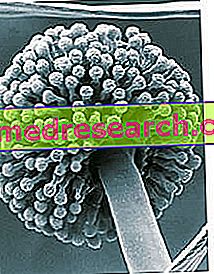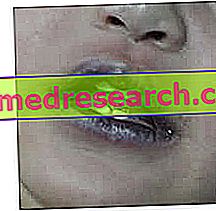Aspergillosis: definition

Let us remember briefly that Aspergillus are commensal mycetes normally present in the body, especially on skin, oral cavity and digestive system: only in certain conditions, these microorganisms can become pathogenic and cause damage, mostly to the respiratory tract.
Aspergillus fumigatus and Aspergillus niger are probably the two species of greatest pathological interest, therefore the most involved in aspergillosis.
To learn more: Aspergillosis symptoms
Classification
The most common aspergilloses are classified into:
- ALLERGIC ASPERGILLOSIS or bronchial: a widespread form of aspergillosis, the result of a violent hypersensitivity reaction triggered by the inhalation of Aspergillus spores. This form is manifested by:
- asthma
- allergic bronchopneumonia → fibrosis of the lung segments, dyspnea and bronchiectasis
This variant of aspergillosis manifests itself above all in previously sensitized patients, who again come into contact with the conidia of the aspergillus. Tissue damage is dependent on the host's immune reaction.
Allergens → IgE production → the antigen-antibody complex activates the mast cells → histamine release → bronchospasm and mucus production in the bronchioles
Allergic aspergillosis is common especially in cystic fibrosis and severe asthma sufferers. The clinical and symptomatic picture is manifested by intense dyspnea, bronchospasm, malaise and cough.
When not carefully treated, allergic bronchopulmonary aspergillosis can cause permanent lung damage (pulmonary fibrosis).
- LOCAL NON-INVASIVE ASPERGILLOSIS (there is no invasion of contiguous tissues):
- Pulmonary aspergilloma (or mycetoma) / of the paranasal sinuses or intracavitary aspergillosis. The aspergilloma consists of the formation of hyphae within the pulmonary cavity. Initially asymptomatic, aspergilloma subsequently manifests itself with chronic cough, weakness, loss of appetite, anorexia and hemoptysis.
- Otomycosis: the most involved etiopathological agent is Aspergillus niger . The symptomatic picture is characterized by pain, edema, erythema and itching. Aspergillus grows on debris and ear wax at the level of the external ear.
- Onychomycosis: similarly to otomycosis, also in onychomycosis the most responsible causal agent is Aspergillus niger. The most common symptoms are: pain, edema, erythema and itching.
- Eye infections (eg conjunctivitis)
- Primary cutaneous aspergillosis: typical of patients with pressure sores / burns and paraplegics; the distinctive signs of this aspergillosis are comparable to a dermatomycosis.
The signs and symptoms that characterize non-invasive aspergillosis are cough and hemoptysis.
- INVASIVE or diffuse ASPERGILLOSIS: the invasion of blood by hyphae can cause blood clots, heart attacks and bleeding. Typical of the severely immunocompromised patient, this form of aspergillosis is probably the most dangerous, and presents a high mortality.
- Disseminated invasive aspergillosis: causes gastrointestinal, cerebral, hepatic, renal, cutaneous and ocular problems. It seems particularly common among immunocompromised patients, especially when subjected to solid organ transplantation. The mycelium develops in the lung, and then expands into the brain, skin and heart.
- Invasive pulmonary aspergillosis (probably the most common form)
- Rino-sinus and tracheobronchial invasive aspergillosis
Invasive aspergillosis occurs mainly among leukemia patients, transplanted and AIDS patients. Even patients on prolonged therapy with high-dose corticosteroids are at risk of Aspergillus infections.
The symptomatology is characterized by rather vague and non-specific symptoms: dyspnoea, chest pain, fever, hemoptysis, cough (generally not productive).
Diagnosis
In case of suspected aspergillosis, the patient undergoes general diagnostic tests, such as chest radiography and computed tomography. When the tests show unmistakable signs of infection, we proceed with a more specific investigation to isolate the fungus from samples of pleural exudate, bronchial secretions or from bronchoscopy samples. Broncho-alveolar lavage or endotracheal aspirate are further investigations used for culture and microscopic observation.
For cytological examination, the presence of calcium oxalate crystals is an indicator light of aspergillosis. The culture test, useful for accurately detecting the etiological agent, is performed on sabourad agar medium, while the histological diagnosis uses the hematoxylin-eosin stain.
Not to forget, however, that the search for Aspergillus in the sputum can give false positives: in the oral cavity, in fact, some commensal species of Aspergillus can coexist.
Care
Unfortunately, invasive aspergillosis gives poor prognosis in the vast majority of cases: in order to avoid similar consequences, it is recommended to seek medical attention even in the case of suspected aspergillosis.
Let us briefly recall that in healthy subjects, aspergillus infections should not alarm excessively: in fact, aspergillosis tends to occur almost exclusively in immunocompromised patients.
The mild forms of aspergillosis (allergic variants) are easily treated.
The most commonly used drugs for aspergillosis therapy are antifungals (eg voriconazole, posaconazole, caspofungin and Amphotericin B). In order to exert an intense anti-inflammatory action, corticosteroids can also be useful in case of aspergillosis associated with asthma and / or cystic fibrosis.



